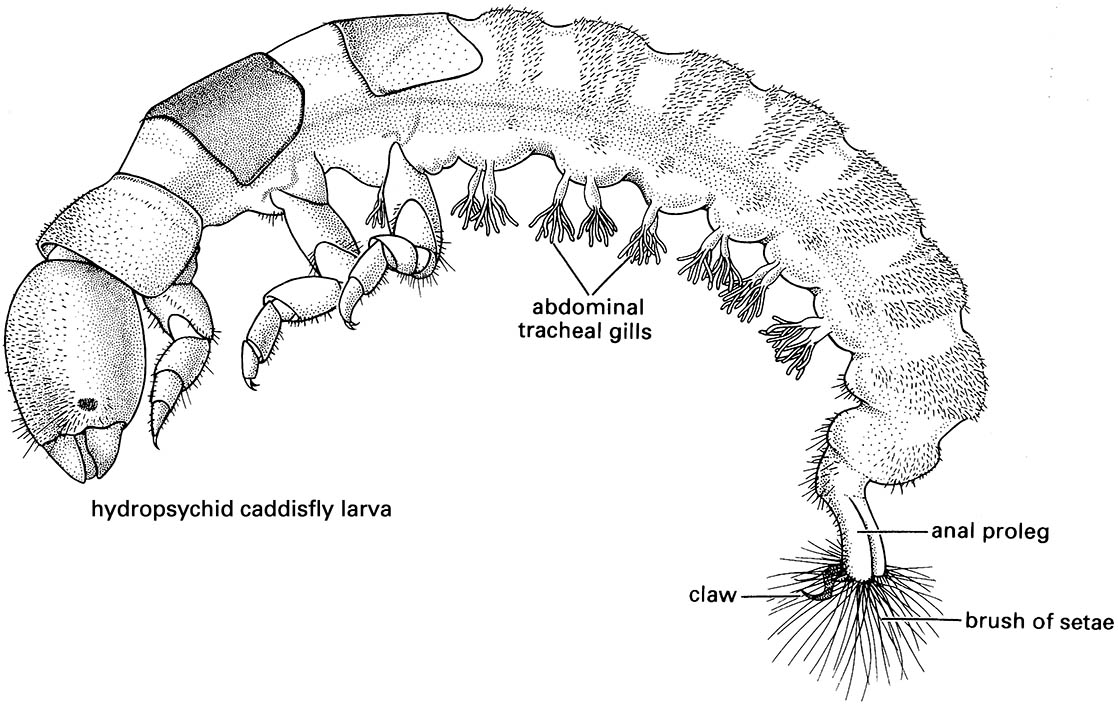Box 10.4. Trichoptera (caddisflies)
Caddisflies comprise an order of over 11,000 described species and more than 40 families found worldwide. They are holometabolous, with a moth-like adult (as illustrated here for a hydropsychid) usually covered in hairs; setal warts (setose protuberances) often occur on the dorsum of the head and thorax. The head has reduced mouthparts, but with three- to five-segmented maxillary palps and three-segmented labial palps (cf. the proboscis of most Lepidoptera). The antennae are multisegmented and filiform, often as long as or longer than the wings. There are large compound eyes and two or three ocelli. The prothorax is smaller than the meso- or metathorax, and the wings are haired or sometimes scaled, although they can be distinguished from lepidopteran wings by their different wing vena- tion, including anal veins looped in the fore wings and no discal cell. The abdomen typically is 10-segmented, with the male terminalia more complex (often with claspers) than in the female.
The larvae have five to seven aquatic instars, with fully developed mouthparts and three pairs of thoracic legs, each with at least five segments, and without the ventral prolegs characteristic of lepidopteran larvae. The abdomen terminates in hook-bearing prolegs. The tracheal system is closed, with tracheal gills often on most or all nine abdominal segments (as illustrated here for a hydropsychid, Cheumatopsyche sp.), and sometimes associated with the thorax or anus. Gas exchange is also cuticular, enhanced by ventilatory undulation of the larva in its tubular case. The pupa is aquatic, enclosed in a silken retreat or case, with large functional mandibles to chew free from the pupal case or cocoon; it also has free legs with setose mid-tarsi to swim to the water surface; its gills coincide with the larval gills. Eclosion involves the pharate adult swimming to the water surface, where the pupal cuticle splits; the exuviae are used as a floating platform.
Caddisflies are predominantly univoltine, with development exceeding one year at high latitudes and elevations. The larvae are saddle-, purse-, or tube-case-making (Fig. 10.6), or free-living, net-spinning (Fig. 10.7); they exhibit diverse feeding habits and include predators, filterers, and/or shredders of organic matter, and some grazers on macrophytes. Net-spinners are restricted to flowing waters, with case-makers frequent also in standing waters. Adults may ingest nectar or water, but often do not feed.
Phylogenetic relations are discussed in section 7.4.2 and depicted in Fig. 7.2.



(a) Helicopsychidae; (b) Philorheithridae; (c) and (d) Leptoceridae.

(After Wiggins 1978)

Broken lines indicate uncertain relationships. Thysanura sensu lato refers to Thysanura in the broad sense. (Data from several sources)



